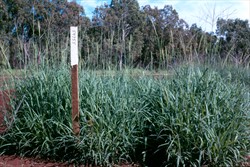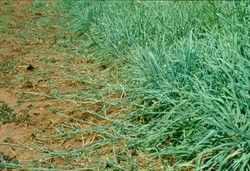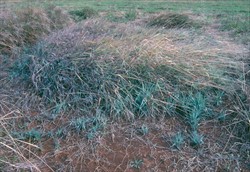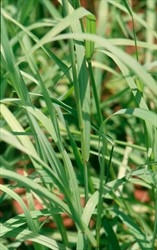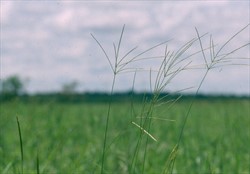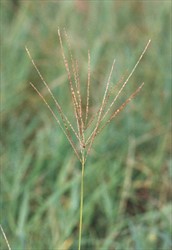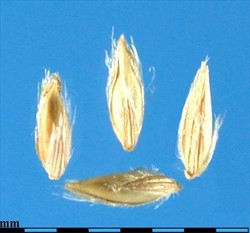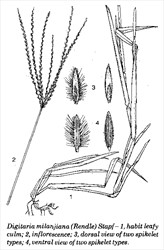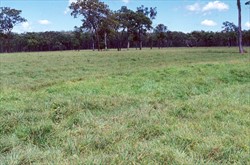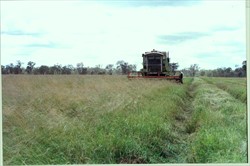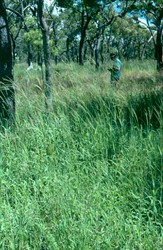Digitaria milanjiana
Tropical Forages
Digitaria milanjiana (Rendle) Stapf
Basionym: Panicum milanjianum Rendle; Digitaria endlichii Mez; Digitaria kilimandscharica Mez; Digitaria milanjiana subsp. eylesiana Henrard; Digitaria milanjiana var. abscondita Henrard; Digitaria mombasana C.E. Hubb.; Digitaria swynnertonii Rendle
Family: Poaceae (alt. Gramineae) subfamily: Panicoideae tribe: Paniceae subtribe: Anthephorinae.
Stoloniferous, rhizomatous or tufted perennial; culms decumbent, geniculately ascending or erect to 150 (‒250) cm high at maturity; culm nodes glabrous, rarely hairy. Leaf-sheath glabrous or variously pubescent (pilose, rarely tomentose or with papillose-based hairs) at base; auricles present; ligule an eciliate membrane 0.8‒2.5 mm long; leaf-blades to about 40 cm long, 2‒8 (‒13) mm wide, near glabrous to densely villous (leaf dimensions, colour and pubescence vary with provenance); margins scabridulous. Inflorescence a digitate or subdigitate (axis to 6 cm long) panicle comprising (2‒) 3‒12 (‒18) racemes (rarely 2 and up to 18), 8‒25 cm long; spikelets 2.5‒3.5 mm long, 0.7‒0.9 mm wide, lanceolate, in unequally pedicellate pairs; lower glumes 0.2‒0.5 mm, acute to truncate; upper glumes (1.2‒) 1.6‒2.3 mm, from ⅕ as long as to almost equaling the spikelets; lower lemmas 2.5‒3.5 mm, 7-veined, veins unequally spaced, midvein and lateral veins scabrous at least on the distal ½, margins and region between the inner 2 lateral veins with straight, yellowish, 0.6‒1 mm hairs; upper lemmas gray to tan at maturity. About 2‒2.5 million seeds/kg.
Similar species
D. milanjiana: hairs yellowish or brown; nerves of the lower lemma scaberulous.
D. eriantha: hairs white to grey; nerves of the lower lemma are smooth.
Africa: Makarikari vingergras, Milanje vingergras, panvingergras (Afrikaans); kakondo ka uffele (Swahili); ǁoqʼm (Juǀ'hoan); sindesinde, thingandu (Namibia, Thimbukushu); hidoo (Ethiopia)
Asia: 细茎马唐 (China); rumput digit (Malaysia); ya mardi digit (Thailand)
English: digit grass, Makarikari finger grass, milanje finger grass, milanje grass, tall finger grass, woolly finger grass; Madagascar crabgrass (USA); jarra grass (Australia)
Latin America: milanjiana (Spanish)
Native:
Africa: Angola; Botswana; Democratic Republic of Congo; Ethiopia; Kenya; Malawi; Mozambique; Namibia; Somalia; South Africa (Free State, Mpumalanga, Gauteng, North West, Limpopo); Tanzania; Uganda; Zambia; Zimbabwe
Naturalized:
Northern America: USA (Florida)
Cultivated:
Africa: Ghana
Asia: Malaysia; Thailand; Vietnam
Australasia: Australia (Northern Territory, Queensland)
Caribbean: Puerto Rico
Pacific: Fiji
Forage
Long-term grazed pasture, but also suitable for cut-and-carry and hay.
Environment
Ground cover for erosion protection.
Other
'Jarra' has been planted vegetatively as a break crop between banana rotations to provide ground cover and suppress weeds. It has also been found that a grass rotation of 2 years breaks the life cycle of the burrowing nematode (Radopholus similis).
Common in disturbed areas and abandoned cultivations.
Soil requirements
D. milanjiana is mostly found on lighter soils (sands, sandy loam, loams and clay loams) rarely on heavy black clays (vertisols). pH at collection sites ranges from (4.5‒) 6.0 to 7.0 (‒8.5). It can survive under fairly low fertility conditions, but responds to improved fertility, particularly nitrogen.
Moisture
Occurs naturally in areas with annual rainfall from 400 to 1,700 mm, either bimodal, or over 5‒6 months with a prolonged dry season. It generally prefers well-drained soils. It is very drought tolerant but does not tolerate waterlogging. Ecotypes within the related species, D. swynnertonii, can be grown on heavy black clay soils and are tolerant of seasonally waterlogging (see cv. Arnhem).
Temperature
It is found over a wide latitudinal range, from about 8º N to 26º S and at altitudes from 0 to >2,000 m asl. It exhibits a predominantly warm season growth pattern, but still with moderate production either side of summer. In cultivation it has extended farther into the subtropics to about 30º S. Tops are killed but plants recover from tufts and plantlets along the stolons.
Light
In its native environment, it occurs in grassland, savannah or woodland, in tall and short grass associations, and, like D. eriantha, is generally considered to have poor shade tolerance.
Reproductive development
Appears to be a quantitative long day plant, flowering commences soon after resumption of growth after winter or the dry season, and reaching a peak in mid-summer.
Defoliation
Very tolerant of grazing or cutting. However, extreme palatability of some provenances can lead to decline in heavily grazed pastures.
Fire
Recovery after fire better than D. eriantha (pangola grass), although some ecotypes better than others.
Guidelines for establishment and management of sown forages.
Establishment
Freshly harvested seed is dormant, with ecotypes from high rainfall areas having short dormancy and ecotypes from low rainfall having extended dormancy. Germination improves with >5 months of storage. Experimentally, dormancy can be broken by removing the palea and lemma from around the caryopsis. Seed is sown at 1‒4 kg/ha depending on seedbed preparation and proposed application.
Fertilizer
On less fertile soils, seed should be sown with 10‒20 kg/ha P, with annual maintenance applications of 5‒10 kg/ha P. Potassium may be required on some soils where soil analysis or plant symptoms indicate deficiency. Needs at least 100 kg/ha/yr N to be productive in less fertile soils.
Compatibility (with other species)
Not as competitive as many of the tropical grasses, but sward-forming types may suppress legume seedling recruitment.
Companion species
Grasses: Generally not sown with other grasses.
Legumes: Aeschynomene americana, Centrosema brasilianum, Centrosema pascuorum, Chamaecrista rotundifolia, Clitoria ternatea, Leucaena leucocephala, Macroptilium atropurpureum, M. gracile, Stylosanthes hamata, S. scabra.
Pests and diseases
Generally good field resistance to rust (Puccinia oahuensis). Adults and larvae of crab grass leaf beetle (Lema rufotincta) can severely damage seedlings and young leaf tissue during the early part of the wet season in northern Australia. Natural predators usually quickly control this small beetle. Leaf-cutting ant (Acromyrmex landolti) is attracted to D. milanjiana in Paraguay (more so than to Urochloa brizantha or Cenchrus ciliaris). It is a host for the sugarcane mealy bug Heliococcus summervillei (Pseudococcidae).
Ability to spread
Creeping types spread from seed if conditions are favourable or gradually from stolons. Soil disturbance or open space is necessary for spread by seed.
Weed potential
Recorded as a weed in cultivation in Africa.
Nutritive value
Depends on soils fertility and age of growth. CP from 8 to >12%, and average IVDMD in 4- and 8-week old material from 64 to 67%. CP digestibility in hay about 55%. Green leaf recorded at 2.11% N, 0.28% P, 0.16% S, and 0.84% Ca in the dry matter. There is considerable genetic variation in sodium content of D. milanjiana strongly related to geographic origin of provenances tested.
Palatability/acceptability
Mostly an extremely palatable species, with some provenances more palatable than others. 'Jarra' and 'Strickland' both considered more palatable than 'Arnhem' and Digitaria eriantha (pangola). Well eaten by all classes of stock, including the wild fauna of Africa, and magpie geese and wallabies in Australia.
Toxicity
No record of toxicity.
Feedipedia link
April 2020: Page under construction
Dry matter
Yields up to 34 t/ha/yr DM, depending on fertilizer application and growing conditions. More commonly 10‒20 t/ha/yr DM.
Animal production
No information available.
Seed dormancy in D. milanjiana is related both to polyploidy and rainfall of provenance and that genetic adaptation to arid regions has been associated with polyploidisation and increasing dormancy. Heritibility of growth form, nutritive value, and cation relationships (Na: K) have been established.
This is a cross-pollinating species, 2n = 18, 34, 36, 45, 54, 72.
In some environments, it is possible to obtain 3 harvests/yr. In the Northern Territory of Australia (southern hemisphere, tropics), 'Arnhem' can produce crops in November/December, late January/February and April, each producing about 100 kg/ha seed. In the same environment, 'Strickland' produces a light December crop, followed by up to 100 kg/ha seed in February, and a further 40‒50 kg/ha in April/May. In north Queensland, 'Jarra' also flowers throughout the growing season, with a distinct peak in mid-summer. A single harvest from this flowering can yield 200 kg/ha seed, and up to 250 kg/ha in January/February. Similarly with 'Strickland' in southern Queensland (subtropics), using a clearing cut and fertilizing with 100‒150 kg/ha N in November/early December, seed yields of 200‒250 kg/ha can be obtained. Initial attempts to obtain 2 crops per season resulted in light crops totalling less than the mid-season crop. Yields are lower in less favourable moisture and fertility conditions, and may be more of the order of 80‒100 kg/ha. Large areas tend to produce more seed than small plots, possibly due to improved pollination opportunities. Seed crops can be harvested with a beater harvester, a brush harvester or a conventional header, usually when about 10% of mature seed has been shed.
Susceptible to glyphosate.
- Very palatable.
- Drought-hard.y
- No serious disease.
- Grows on most soils.
- Intolerant of poor drainage.
- Flowers throughout the growing season, becoming stemmy.
- Frost tender.
Bogdan, A.V. (1977) Tropical Pasture and Fodder Plants. Longman Inc., New York, USA. p. 123–124.
Gibbs Russell, G.E., Watson, L., Koekemoer, M., Smook, L., Barker, N.P., Anderson, H.M. and Dallwitz, M.J. (1990) Grasses of Southern Africa: An identification manual. Memoirs of the Botanical Survey of South Africa No. 58. Botanical Research Institute, Pretoria, South Africa.
Hacker, J.B. (1984) Genetic variation in seed dormancy in Digitaria milanjiana in relation to rainfall at the collection site. Journal of Applied Ecology 21:947–959. doi.org/10.2307/2405059
Hacker, J.B. (1988) Polyploid distribution and seed dormancy in relation to provenance rainfall in the Digitaria milanjiana complex. Australian Journal of Botany 36:693–700. doi.org/10.1071/BT9880693
Hacker, J.B. and Wong, C.C. (1992) Digitaria milanjiana (Rendle) Stapf. In: Mannetje, L.’t and Jones, R.M. (eds) Plant Resources of South-East Asia No. 4. Forages. Pudoc Scientific Publishers, Wageningen, the Netherlands. p. 123–124. edepot.wur.nl/327785
Lowe, K.F., Moss, R.J., Cowan, R.T., Minson, D.J. and Hacker, J.B. (1991) Selecting for nutritive value in Digitaria milanjiana. 4. Milk production from elite genotype compared with Digitaria eriantha ssp. pentzii (pangola grass). Australian Journal of Experimental Agriculture 31:603–608. doi.org/10.1071/EA9910603
Minson, D.J. and Hacker, J.B. (1986) Selecting for nutritive value in Digitaria milanjiana. 2. Intake and digestibility of divergently selected full-sibs compared with Digitaria decumbens. Australian Journal of Experimental Agriculture 26:551–556. doi.org/10.1071/EA9860551
'Arnhem' (CPI 59749) Released in Northern Territry, Australia (1996). Introduced as D. swynnertonii. Origin Mozambique (20º S; 45 m asl, rainfall 1,200 mm). Tussock habit (no stolons); leaves green, glabrous. Foliage to 70 cm and flowering stems to 1.5 m. Suited to areas receiving annual rainfall of over 1,100 mm. It will grow well on a wide range of soil types including lithosols, red earths, sandy red earths, yellow earths and seasonally flooded solodic soils. Can withstand up to 3 months waterlogging. Tolerant of flooding and occasional burning. Drought tolerant. Less palatable than Digitaria eriantha (pangola), 'Jarra' or 'Strickland'. Tolerant of heavy stocking.
'Jarra' (CPI 59745) Released in Australia (1991). Origin Malawi (16º S, 61 m asl, rainfall 700 mm, well drained loam, pH 7.5). Stoloniferous. Foliage to 1 m and flowering stems to 1.8 m high. Leaves broad, dark green and purple, somewhat hairy, superficially resembling the annual, D. bicornis. Suited to areas receiving annual rainfall of over 1,100 mm. Can persist with 900 mm of annual rainfall but with reduced productivity. Successful on a range of soil types from coarse granitic sandy loams, alluvial loams, and shallow solodics, to a euchrozem. Better than 'Strickland' in higher rainfall areas, although more sensitive to waterlogging. Resistant to burrowing nematode (Radopholus similis), a serious economic pest of bananas, where 'Jarra' is used as a ground cover between rotations. A grass rotation lasting 2 years with no weed hosts can break the burrowing nematode cycle.
'Strickland' (CPI 40700, PI 299792) Released in Australia (1995). Held by USDA as D. eriantha (formerly Digitaria setivalva). Origin Botswana (Lake N'Gami, Kalahari; 20º S, 940 m asl, rainfall 465 mm). Stoloniferous. Foliage to 1 m and flowering stems to 1.5 m high. Leaves grey-green. Suited to areas receiving annual rainfall >900 mm, although persists with less. Very drought tolerant, better than 'Jarra'. Withstands some waterlogging but not prolonged flooding. Successful on sands to clays, including solodics, lithosols, yellow earths, red earths and sandy red earths.
CPI 41192 (PI 299782) Selected in Australia (Queensland). Introduced as D. polevansii from USA. Also referred to as D. seriata and D. eriantha. Tufted stoloniferous grass, very hairy leaves. High yielding with good persistence in both humid and dry subtropics.
CPI 59752 Selected in Australia (Queensland). Held in gene bank as D. natalensis but similar in appearance and behaviour to D. milanjiana. Origin Zimbabwe (16º S, 545 m asl, rainfall 650 mm). Robust, persistent, leafy, broad-leafed, to 1.8 m at maturity. Develops strong stolons, also forms below rhizomes. Extremely palatable. Possibly better suited to rainfall above 900 mm, but persists at less.
CPI 59755 Selected in Australia (Queensland). From Victoria Falls, Zimbabwe (18º S, 818 m asl, rainfall 650 mm). Leafy, broad-leafed, extremely palatable, persistent type. Possibly better suited to rainfall above 900 mm, but persists at less.
CPI 59761 Selected in Australia (Queensland). Origin Zimbabwe (22º S, 500 m asl, rainfall 450 mm). Rated "good dense sward, palatable" in seasonally dry tropics.
CPI 59777 Selected in Australia (Queensland). Introduced as D. pentzii. Origin Victoria Falls, Zimbabwe (18º S, 818 m asl, rainfall 650 mm). Leafy, broad-leafed, extremely palatable, persistent type, similar to CPI 59755 but more stoloniferous. Possibly better suited to rainfall above 900 mm, but persists at less.
CPI 59786 Selected in Australia (Queensland). From Zimbabwe (21º S, 545 m asl, rainfall 500 mm). Collected as D. pentzii. Rated "exceptional" in dry upland tropics, and "best" in sub-humid lowlands at 24º S.
CPI 59829 Selected in Australia (Queensland). From South Africa (23º S, 970 m asl, rainfall 425 mm). Collected as D. setivalva. Rated "excellent" in dry upland tropics.
CPI 125658 Selected in Paraguay. Origin Bulawayo, Zimbabwe (19.31º S, 1,200 m asl, rainfall 600 mm). Stoloniferous and rhizomatous; prolific seed producer.
